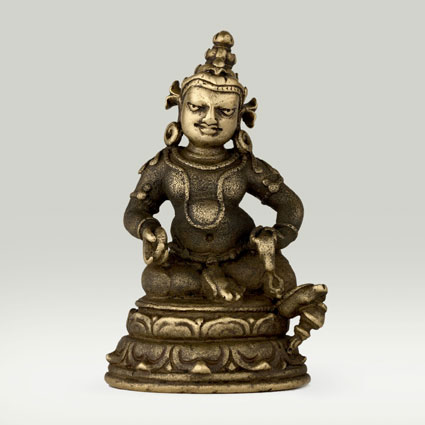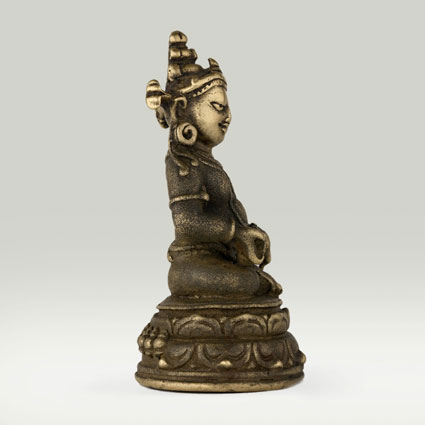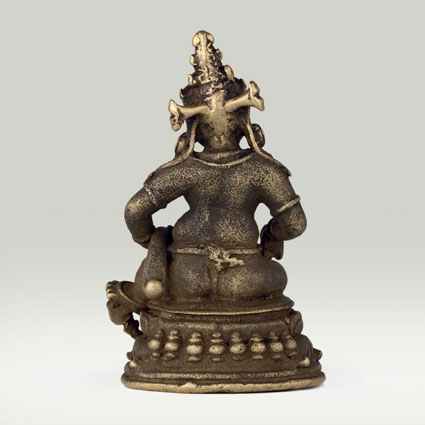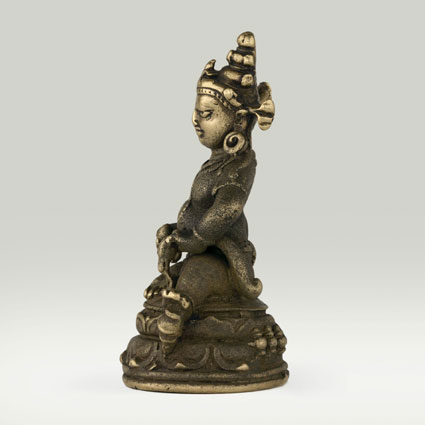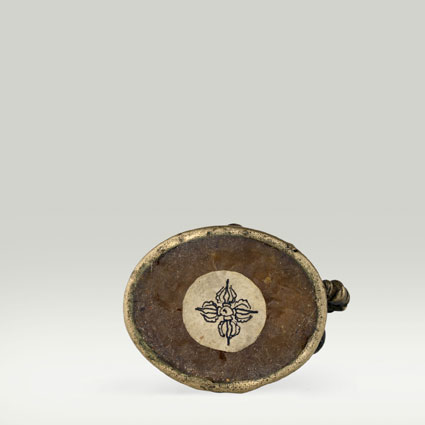ABS 023
Code: ABS 023
Country: India (north-east)
Style: Late Pala Style
Date: 900 - 1000
Dimensions in cm WxHxD: 5.9 x 10.2 x 4.9
Materials: Brass
The yellow form of Jambhala, known as Pita Jambhala (Tib. Dzam bha la ser po)
The yellow Jambhala is seated in the attitude of ease (lalitasana) one a double lotus pedestal and rests his left foot on a “full vase” emblem (nidhi). He holds a fruit in his right hand, which is extended in the gesture of charity (varada-mudra). The left hand is resting on the left knee and caresses gem-spouting mongoose (nakula), the attribute of Jambhala, Kubera and Vaishravana, among the deities associated with prosperity. Jambhala is clad with a cloth tied below the protruding belly. He is decorated with ornaments, namely a bejewelled knot of hair, circular earrings, two necklaces and ornaments at the upper arms, wrists and ankles.
The back side of the pedestal is decorated with eight “vases of plenitude” (nidhi). They represent according to the Markandeya-Purana the eight treasures of the Yakshas, namely Padma, Mahapadma, Makara, Kacchapa, Mukunda, Nila, Nanda and Sankha.
Both Kubera (in Hindu-religions) and Jambhala are linked to Vaishravana, even though they each can appear under different aspects. Under the name of Vaishravana, the deity is one of the guardians of the cardinal directions, and reigns over the north. Under the name of Kubera, he is the god of wealth. He wears the five-fold bodhisattva crown and carries the banner of victory with the wish fulfilling jewel in his right hand. Sometimes he rides on a snow lion. In Tibetan Buddhism he appears under the name of Jambhala. He is a protector in all the lineages, and is considered to be an emanation of Avalokiteshvara (tib.: Chenrezig), representing compassion and generosity. Jambhala appears under five different forms and colours, and each is linked to one of the five victorious Buddhas, showing different attitudes and attributes. The yellow Jambhala is the most popular. His mantra is: Om Jambhala Jalendraye Svaha. The jewel-spitting mongoose is always present, and clearly identifies these deities of wealth.
Wealth is considered to provide freedom, so that one may focus on the path of spirituality rather than on materiality and worries about the temporality of wealth.
The puja dedicated to the five Jambhalas is believed to summon positive wealth energies upon the participants. Even though wealth is supposed to result from one’s past actions, it is nevertheless believed that this puja can play a significant role in changing the course of one’s financial situation.
The yellow Jambhala is seated in the attitude of ease (lalitasana) one a double lotus pedestal and rests his left foot on a “full vase” emblem (nidhi). He holds a fruit in his right hand, which is extended in the gesture of charity (varada-mudra). The left hand is resting on the left knee and caresses gem-spouting mongoose (nakula), the attribute of Jambhala, Kubera and Vaishravana, among the deities associated with prosperity. Jambhala is clad with a cloth tied below the protruding belly. He is decorated with ornaments, namely a bejewelled knot of hair, circular earrings, two necklaces and ornaments at the upper arms, wrists and ankles.
The back side of the pedestal is decorated with eight “vases of plenitude” (nidhi). They represent according to the Markandeya-Purana the eight treasures of the Yakshas, namely Padma, Mahapadma, Makara, Kacchapa, Mukunda, Nila, Nanda and Sankha.
Both Kubera (in Hindu-religions) and Jambhala are linked to Vaishravana, even though they each can appear under different aspects. Under the name of Vaishravana, the deity is one of the guardians of the cardinal directions, and reigns over the north. Under the name of Kubera, he is the god of wealth. He wears the five-fold bodhisattva crown and carries the banner of victory with the wish fulfilling jewel in his right hand. Sometimes he rides on a snow lion. In Tibetan Buddhism he appears under the name of Jambhala. He is a protector in all the lineages, and is considered to be an emanation of Avalokiteshvara (tib.: Chenrezig), representing compassion and generosity. Jambhala appears under five different forms and colours, and each is linked to one of the five victorious Buddhas, showing different attitudes and attributes. The yellow Jambhala is the most popular. His mantra is: Om Jambhala Jalendraye Svaha. The jewel-spitting mongoose is always present, and clearly identifies these deities of wealth.
Wealth is considered to provide freedom, so that one may focus on the path of spirituality rather than on materiality and worries about the temporality of wealth.
The puja dedicated to the five Jambhalas is believed to summon positive wealth energies upon the participants. Even though wealth is supposed to result from one’s past actions, it is nevertheless believed that this puja can play a significant role in changing the course of one’s financial situation.

